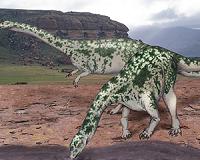 |
New Haven, Conn. (UPI) Oct 15, 2010 The king of the dinosaurs, Tyrannosaurus rex, didn't just have an appetite for other dinosaurs -- it was happy to eat its own kind, U.S. paleontologists say. Yale University researcher Nick Longrich was examining dinosaur bones for mammal tooth marks when he discovered a bone with exceptionally large gouges that could only have been made by T. rex -- but the bone in question was also from T. rex, a university release said Friday. "They're the kind of marks that any big carnivore could have made, but T. rex was the only big carnivore in western North America 65 million years ago," Longrich said. More searching through several different museum fossil collections turned up more T. rex bones with T. rex bite marks, he said. "It's surprising how frequent it appears to have been," Longrich said. "We're not exactly sure what that means." The marks are definitely the result of feeding, although scientists aren't sure whether they are the result of scavenging or the end result of fighting, Longrich said. If two T. rex fought to the death, he said, the victor might have made a meal out of its adversary. "Modern big carnivores do this all the time," Longrich said. "It's a convenient way to take out the competition and get a bit of food at the same time."
Share This Article With Planet Earth
Related Links Explore The Early Earth at TerraDaily.com
 New Fossil Suggests Dinosaurs Not So Fierce After All
New Fossil Suggests Dinosaurs Not So Fierce After AllAustin TX (SPX) Oct 13, 2010 A new species of dinosaur discovered in Arizona suggests dinosaurs did not spread throughout the world by overpowering other species, but by taking advantage of a natural catastrophe that wiped out their competitors. Tim Rowe, professor of paleontology at The University of Texas at Austin's Jackson School of Geosciences, led the effort to describe the new dinosaur along with co-authors Han ... read more |
|
| The content herein, unless otherwise known to be public domain, are Copyright 1995-2010 - SpaceDaily. AFP and UPI Wire Stories are copyright Agence France-Presse and United Press International. ESA Portal Reports are copyright European Space Agency. All NASA sourced material is public domain. Additional copyrights may apply in whole or part to other bona fide parties. Advertising does not imply endorsement,agreement or approval of any opinions, statements or information provided by SpaceDaily on any Web page published or hosted by SpaceDaily. Privacy Statement |